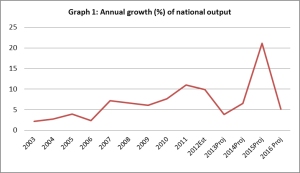Economic Growth Report of Vanuatu
Small Pacific Island countries like Vanuatu. With it’s annual growth at 5, 6, 7% per annum, Vanuatu is no different than it’s pacific island neighbors but it has the potential to further increase economic growth by building better relationships with Asia and the North Pacific and expanding it’s job sectors by encouraging information technology throughout the nation.
Geography no longer an obstacle on economic growth: ADB
In a special report in its latest Pacific Economic Monitor, the Asian Development Bank says remote geography need not be the barrier to growth that many think it is.
ADB Economist, Emma Veve, told Jemima Garrett the Bank has been getting more involved in projects to connect Pacific countries to the world through sub-marine fiber optic cables.
Presenter: Jemima Garrett
Speaker: Emma Veve, Principal Economist with the Asian Development Bank’s Pacific Department
VEVE: We expect that faster internet speed to provide real benefits to businesses operating in these economies, particularly tourism, businesses for example where people can now more easily book online, get information about the countries. But also more use of the Pacific countries for back office operations of large multinational corporations. The people who answer the phones and answer your questions about your bank accounts etc. The Pacific countries have people who speak English as their first language, and they’re in a great time zone and spread across a number of time zones, so are well able to access these business opportunities. And what was holding them back in the past was lack of good telecommunications.
GARRETT: Internet costs are still high in many countries. Doesn’t that present the same sort of problems that those countries have always faced from their remote geography and dispersed islands?
VEVE: Absolutely, some countries have very high internet prices at the moment, and in parallel with putting in cables to connect the countries, what’s needed is looking at the regulation and the management of the telecommunication industries in these countries. Where we have monopoly providers, we need to make sure they’re not extracting too much rent from the business opportunity they have, and that prices that are charged for internet are indeed competitive.
GARRETT: What opportunities do you see for the small Pacific countries to make more out of their links with Asia and the north Pacific?
VEVE: Well in sort of historical tradition these countries were very closely linked towards the US, Australia, New Zealand as trade partners. But in recent years we’ve really seen a move of more imports coming directly from Asia, and increasingly exports going to Asian countries from these small island countries. Exports of copra, virgin coconut oil for example, are all valued in Asia, and exporting directly there is a good idea for these countries.
GARRETT: You say that streamlining regulations on investment and services trade is critical. What sort of changes are needed?
VEVE: Yes having links into the Asian economies for example, local firms might want to work closely with Asian firms, and so being able to have foreign investment happening quickly and smoothly in these countries. For example making investment regulations similar across a group of countries, which will then enable perhaps companies operating in one Pacific Island at the moment to more easily expand and operate in multiple Pacific Islands, without having to deal with very differing rules and regulations in each country.
GARRETT: You also say that there’s a need to build up the appropriate supporting institutions to make better trade with Asia possible. What do you mean by that exactly?
VEVE: Well ministries of commerce, industry, trade are all vital partners for small companies who want to access markets overseas, providing information on the arrangements in place in the island countries to the Asian companies who might be interested, helping organize trade missions, helping identify opportunities for the local companies to access are all important roles for government to facilitate trade and investment.
GARRETT: Another opportunity for people in the smaller Island states to move out of the low growth conundrum is jobs overseas, labor mobility. How much potential do you see for that?
VEVE: I think there’s significant potential for labor mobility in the Pacific and in fact we’re already seeing a lot. Countries like Tuvalu and Kiribati have been renowned for years for their provision of seafarers. It’s expanding that, we’re looking at nurses, teachers, moving out of their own countries, operating elsewhere in the Pacific and outside the Pacific. The remittances they provide back to their families provide a vital source of income for those families and help support the growth and development of the country. So I think there’s more potential for that, and across a wider range of areas, so that skilled workers are being sent overseas and the remittances coming back are significant.
GARRETT: Up until now the smaller Island states have had difficulty  posting growth much over two per cent. That makes it hard to reduce poverty. What sort of growth could these countries expect if they’re making more of the opportunities that we have been talking about here?
posting growth much over two per cent. That makes it hard to reduce poverty. What sort of growth could these countries expect if they’re making more of the opportunities that we have been talking about here?
VEVE: It’s always hard to predict your potential growth and you really don’t want to put a constraint on what the growth might be for a country by picking a number. But certainly one, two per cent growth is exceedingly low. We have seen the Solomon Islands, Vanuatu getting five, six, seven, eight per cent growth quite regularly. What we’d like to see is that kind of growth in other Pacific islands, and there’s a whole range of actions that can be taken to try and free up the economies and really generate that growth, develop the private sectors as the driver of growth in these small economies.
VEVE: We expect that faster internet speed to provide real benefits to businesses operating in these economies, particularly tourism, businesses for example where people can now more easily book online, get information about the countries. But also more use of the Pacific countries for back office operations of large multinational corporations. The people who answer the phones and answer your questions about your bank accounts etc. The Pacific countries have people who speak English as their first language, and they’re in a great time zone and spread across a number of time zones, so are well able to access these business opportunities. And what was holding them back in the past was lack of good telecommunications.
GARRETT: Internet costs are still high in many countries. Doesn’t that present the same sort of problems that those countries have always faced from their remote geography and dispersed islands?
VEVE: Absolutely, some countries have very high internet prices at the moment, and in parallel with putting in cables to connect the countries, what’s needed is looking at the regulation and the management of the telecommunication industries in these countries. Where we have monopoly providers, we need to make sure they’re not extracting too much rent from the business opportunity they have, and that prices that are charged for internet are indeed competitive.
GARRETT: What opportunities do you see for the small Pacific countries to make more out of their links with Asia and the north Pacific?
VEVE: Well in sort of historical tradition these countries were very closely linked towards the US, Australia, New Zealand as trade partners. But in recent years we’ve really seen a move of more imports coming directly from Asia, and increasingly exports going to Asian countries from these small island countries. Exports of copra, virgin coconut oil for example, are all valued in Asia, and exporting directly there is a good idea for these countries.
GARRETT: You say that streamlining regulations on investment and services trade is critical. What sort of changes are needed?
VEVE: Yes having links into the Asian economies for example, local firms might want to work closely with Asian firms, and so being able to have foreign investment happening quickly and smoothly in these countries. For example making investment regulations similar across a group of countries, which will then enable perhaps companies operating in one Pacific Island at the moment to more easily expand and operate in multiple Pacific Islands, without having to deal with very differing rules and regulations in each country.
GARRETT: You also say that there’s a need to build up the appropriate supporting institutions to make better trade with Asia possible. What do you mean by that exactly?
VEVE: Well ministries of commerce, industry, trade are all vital partners for small companies who want to access markets overseas, providing information on the arrangements in place in the island countries to the Asian companies who might be interested, helping organize trade missions, helping identify opportunities for the local companies to access are all important roles for government to facilitate trade and investment.
GARRETT: Another opportunity for people in the smaller Island states to move out of the low growth conundrum is jobs overseas, labor mobility. How much potential do you see for that?
VEVE: I think there’s significant potential for labor mobility in the Pacific and in fact we’re already seeing a lot. Countries like Tuvalu and Kiribati have been renowned for years for their provision of seafarers. It’s expanding that, we’re looking at nurses, teachers, moving out of their own countries, operating elsewhere in the Pacific and outside the Pacific. The remittances they provide back to their families provide a vital source of income for those families and help support the growth and development of the country. So I think there’s more potential for that, and across a wider range of areas, so that skilled workers are being sent overseas and the remittances coming back are significant.
GARRETT: Up until now the smaller Island states have had difficulty posting growth much over two per cent. That makes it hard to reduce poverty. What sort of growth could these countries expect if they’re making more of the opportunities that we’ve been talking about here?
VEVE: It’s always hard to predict your potential growth and you really don’t want to put a constraint on what the growth might be for a country by picking a number. But certainly one, two per cent growth is exceedingly low. We’ve seen the Solomon Islands, Vanuatu getting five, six, seven, eight per cent growth quite regularly. What we’d like to see is that kind of growth in other Pacific islands, and there’s a whole range of actions that can be taken to try and free up the economies and really generate that growth, develop the private sectors as the driver of growth in these small economies.
VEVE: We expect that faster internet speed to provide real benefits to businesses operating in these economies, particularly tourism, businesses for example where people can now more easily book online, get information about the countries. But also more use of the Pacific countries for back office operations of large multinational corporations. The people who answer the phones and answer your questions about your bank accounts etc. The Pacific countries have people who speak English as their first language, and they’re in a great time zone and spread across a number of time zones, so are well able to access these business opportunities. And what was holding them back in the past was lack of good telecommunications.
GARRETT: Internet costs are still high in many countries. Doesn’t that present the same sort of problems that those countries have always faced from their remote geography and dispersed islands?
VEVE: Absolutely, some countries have very high internet prices at the moment, and in parallel with putting in cables to connect the countries, what’s needed is looking at the regulation and the management of the telecommunication industries in these countries. Where we have monopoly providers, we need to make sure they’re not extracting too much rent from the business opportunity they have, and that prices that are charged for internet are indeed competitive.
GARRETT: What opportunities do you see for the small Pacific countries to make more out of their links with Asia and the north Pacific?
VEVE: Well in sort of historical tradition these countries were very closely linked towards the US, Australia, New Zealand as trade partners. But in recent years we’ve really seen a move of more imports coming directly from Asia, and increasingly exports going to Asian countries from these small island countries. Exports of copra, virgin coconut oil for example, are all valued in Asia, and exporting directly there is a good idea for these countries.
GARRETT: You say that streamlining regulations on investment and services trade is critical. What sort of changes are needed?
VEVE: Yes having links into the Asian economies for example, local firms might want to work closely with Asian firms, and so being able to have foreign investment happening quickly and smoothly in these countries. For example making investment regulations similar across a group of countries, which will then enable perhaps companies operating in one Pacific Island at the moment to more easily expand and operate in multiple Pacific Islands, without having to deal with very differing rules and regulations in each country.
GARRETT: You also say that there’s a need to build up the appropriate supporting institutions to make better trade with Asia possible. What do you mean by that exactly?
VEVE: Well ministries of commerce, industry, trade are all vital partners for small companies who want to access markets overseas, providing information on the arrangements in place in the island countries to the Asian companies who might be interested, helping organize trade missions, helping identify opportunities for the local companies to access are all important roles for government to facilitate trade and investment.
GARRETT: Another opportunity for people in the smaller Island states to move out of the low growth conundrum is jobs overseas, labor mobility. How much potential do you see for that?
VEVE: I think there’s significant potential for labor mobility in the Pacific and in fact we’re already seeing a lot. Countries like Tuvalu and Kiribati have been renowned for years for their provision of seafarers. It’s expanding that, we’re looking at nurses, teachers, moving out of their own countries, operating elsewhere in the Pacific and outside the Pacific. The remittances they provide back to their families provide a vital source of income for those families and help support the growth and development of the country. So I think there’s more potential for that, and across a wider range of areas, so that skilled workers are being sent overseas and the remittances coming back are significant.
GARRETT: Up until now the smaller Island states have had difficulty posting growth much over two per cent. That makes it hard to reduce poverty. What sort of growth could these countries expect if they’re making more of the opportunities that we’ve been talking about here?
VEVE: What we’d like to see is that kind of growth in other Pacific islands, and there’s a whole range of actions that can be taken to try and free up the economies and really generate that growth, develop the private sectors as the driver of growth in these small economies.
It’s always hard to predict your potential growth and you really don’t want to put a constraint on what the growth might be for a country by picking a number. But certainly one, two per cent growth is exceedingly low. We’ve seen the Solomon Islands.
Vanuatu is getting five, six, seven, eight per cent growth quite regularly. What we’d like to see is that kind of growth in other Pacific islands, and there’s a whole range of actions that can be taken to try and free up the economies and really generate that growth, develop the private sectors as the driver of growth in these small economies.
Read More about Vanuatu






